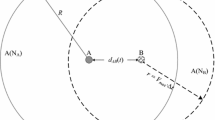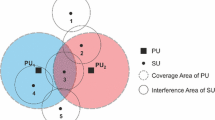Abstract
This paper discusses the issue of routing packets over an IEEE 802.11 ad hoc wireless network with multiple data rates (1/2/5.5/11 Mb/s). With the characteristics of modulation schemes, the data rate of wireless network is inversely proportional with the transmission distance. The conventional shortest path of minimum-hops approach will be no longer suitable for the contemporary multi-rate/multi-range wireless networks (MR2WN). In this paper, we will propose an efficient delay-oriented multi-rate/multi-range routing protocol (MR2RP) for MR2WN to maximize the channel utilization as well as to minimize the network transfer delay from source to destination. By analyzing the medium access delay of the IEEE 802.11 medium access control (MAC) protocol, the proposed MR2RP is capable of predicting the transfer delay of a routing path and finding the best one, which has the minimum transfer delay from source to destination. The proposed MR2RP may choose a longer path but with less contention competitors and buffer queuing delay. Simulation results show that MR2RP performs the load balancing and fast routing very well, and its call blocking probability is obviously lower than that of conventional minimum-hops approach with fixed transmission rate.
Similar content being viewed by others
References
M.S. Alouini, X. Tang and A.J. Goldsmith, An adaptive modulation scheme for simultaneous voice and data transmission over fading channels, IEEE Journal on Selected Areas in Communications 17(5) (1999) 837–850.
C. Andren and J. Boer, Draft text for the high speed extension of the Standard, doc: IEEE P802.11-98/314 (1998).
C. Andren and M. Webster, CCK Modulation Delivers 11 Mbps for High Rate 802.11 Extension, in: Proc. Wireless Symposium/Portable by Design Conference (Spring 1999).
Application Note, Complementary code keying made simple, AN9850, Intersil (October 1999).
M.J. Atallah, Algorithms and Theory of Computation Handbook (CRC Press, 1999).
F. Cali, M. Conti and E. Gregori, IEEE 802.11 wireless LAN: capacity analysis and protocol enhancement, in: Proc. IEEE INFO-COM'98, San Francisco, GA (April 1998) pp. 142–149.
M.H. Callendar, International mobile telecommunications-2000 standards efforts of the ITU, IEEE Personal Communications 4(4) (August 1997) 6–7.
C. Chien el al., Adaptive radio for multimedia wireless links, IEEE Journal on Selected Areas in Communication 17(5) (1999) 793–813.
Data Sheet, Direct Sequence Spread Spectrum Baseband Processor (HFA3860B), No. 4594, Harris Semiconductor (December 1998).
T.A. ElBatt, S.V. Krishnamurthy, D. Connors and S. Dao, Power management for throughput enhancement in wireless ad hoc networks, in: Proc. IEEE ICC'2000 (June 2000) pp. 1506–1513.
M.J.E. Golay, Complementary series, IRE Transactions on Information Theory (April 1961) 82–87.
K. Halford, S. Halford, M. Webster and C. Andren, Complementary code keying for RAKE-based indoor wireless communication, in: Proc. IEEE Internat. Symposium on Circuits and Systems (ISCAS'99) (1999) pp. 427–430.
J.F. Hayes, Adaptive feedback communications, IEEE Transactions on Communications 16 (1968) pp. 29–34.
IEEE 802.11, Part 11: Wireless LAN Medium Access Control (MAC) and Physical Layer (PHY) specifications, IEEE 802.11 Std. (August 1999).
T. Ikeda, S. Sampei and N. Morinaga, The performance of adaptive modulation with dynamic channel assignment in multimedia traffic, in: Proc. IEEE ICUPC'98 (1998) pp. 523–527.
D.B. Johnson and D.A. Maltz, Dynamic source routing in ad-hoc wireless networks, in: Mobile Computing, eds. T. Imielinski and H. Korth (Kluwer Academic, Dordrecht, 1996) chapter 5, pp. 153–181.
G.E. Keiser, Local Area Networks (McGraw-Hill, New York, 1989).
K.M. Khalil, K.Q. Luc and D.V. Wilson, LAN traffic analysis and workload characterization, in: Proc. 15th Conference on Local Computer Networks (1990) pp. 112–122.
L. Kleinrock and F. Tobagi, Packet switching in radio channels. Part II - The hidden terminal problem in carrier sense multiple access and the busy tone solution, IEEE Transactions on Communications 23(12) (1975) 1417–1433.
S.-J. Lee and M. Gerla, Dynamic load-aware routing in ad hoc networks, in: Proc. IEEE ICC'2001, Vol. 10, Helsinki, Finland (June 2001) pp. 3206–3210.
P. Lettieri and M.B. Srivastava, Adaptive frame length control for improve wireless link range and energy efficiency, in: Proc. IEEE INFOCOM' 98 (1998) pp. 564–571.
S. Murthy and J.J. Garcia-Luna-Aceves, A routing protocol for packet radio networks, in: Proc. 1st Annual ACM International Conference on Mobile Computing and Networking (1995) pp. 86–95.
S. Murthy and J.J. Garcia-Luna-Aceves, An efficient routing protocol for wireless networks, Mobile Networks and Applications (MONET) 1(2) (1996) 183–197.
P.Z. Peebles, Probability, Random Variables and Random Signal Principles, 2nd ed. (McGraw-Hill, New York, 1987).
C.E. Perkins and P. Bhagwat, Highly dynamic destination-sequence distance-vector routing (DSDV) for mobile computers, in: Proc. ACM SIGCOMM'94, London, UK (October 1994).
C.E. Perkins and E.M. Royer, Ad hoc on-demand distance vector routing, in: Proc. 2nd IEEE Workshop on Mobile Computer Systems and Applications (WMCSA'99), New Orleans, LA (February 1999) pp. 90–100.
X. Qiu and K. Chawla, On the performance of adaptive modulation in cellular systems, IEEE Transactions on Communications 47 (June 1999) 884–895.
T.G. Robertazzi, Computer Networks and Systems, Queuing Theory and Performance Evaluation, 2nd ed. (Springer, New York, 1994).
E.M. Royer and C.K. Toh, A review of current routing protocols for ad hoc mobile wireless networks, IEEE Personal Communications 6(2) (1999) 46–55.
S.-T Sheu and J. Chen, A novel delay-oriented shortest path routing protocol for mobile ad hoc networks, in: Proc. IEEE ICC'2001, Vol. 6, Helsinki, Finland (June 2001) pp. 1930–1934.
S.-T. Sheu, Y.H. Lee, M.H. Chen, Y.C. Yu and Y.C. Huang, PLFC: the packet length fuzzy controller to improve the performance of WLAN under the interference of microwave oven, in: Proc. IEEE GLOBECOM' 00, Vol. 3 (November 2000) pp. 1427–1431.
R. Sivaswamy, Multiphase complementary codes, IEEE Transactions on Information Theory 24(5) (1978) 546–552.
C.-C. Tseng and C.-L. Liu, Complementary sets of sequences, IEEE Transactions on Information Theory 18(5) (1972).
B. Vucetic, An adaptive coding scheme for time-varying channels, IEEE Transactions on Communications 39 (May 1991) 653–663.
W.T. Webb and R. Steele, Variable rate QAM for mobile radio, IEEE Transactions on Communications 43 (July 1995) 2223–2230.
M. Webster et al., Harris/Lucent TGb Compromise CCK (11 Mbps) Proposal, doc: IEEE P802.11-98/246 (July 1998).
J. Williams, L. Hanzo and R. Steele, Channel-adaptive modulation, in: Proc. 6th Internat. Conference Radio Receivers and Associated Systems (1995) pp. 344–147.
Author information
Authors and Affiliations
Additional information
An erratum to this article can be found at http://dx.doi.org/10.1023/A:1022857409967
Rights and permissions
About this article
Cite this article
Sheu, ST., Tsai, Y. & Chen, J. MR2RP: The Multi-Rate and Multi-Range Routing Protocol for IEEE 802.11 Ad Hoc Wireless Networks. Wireless Networks 9, 165–177 (2003). https://doi.org/10.1023/A:1021845700856
Issue Date:
DOI: https://doi.org/10.1023/A:1021845700856




